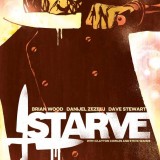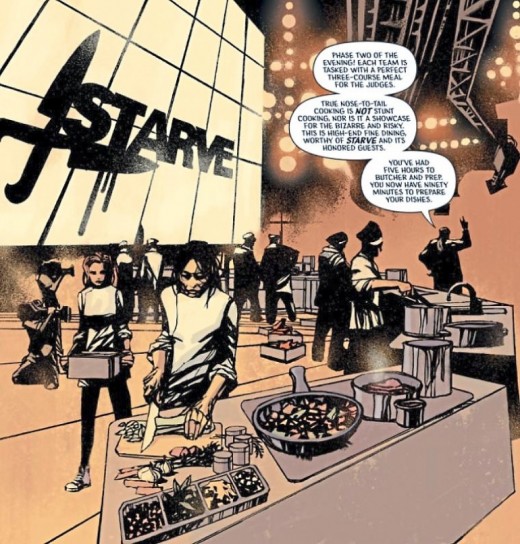
REVIEW: ‘Starve, Vol. 1′ is the Taste of Reality Hell
Brian Wood is no stranger to tackle controversial topics that dominate in our public consciousness right here, right now. He uses the comics as his outlet of critiquing the follies the societies, more particularly the establishments, deliberately or otherwise, embrace. Right now, he targets the very concept of reality television, its innate subliminal forces, and […]
Brian Wood is no stranger to tackle controversial topics that dominate in our public consciousness right here, right now. He uses the comics as his outlet of critiquing the follies the societies, more particularly the establishments, deliberately or otherwise, embrace. Right now, he targets the very concept of reality television, its innate subliminal forces, and the far-reaching consequences it contributes in a not-so-far future. He, alongside with illustrators Daniel Zezelj and Dave Stewart, unleashes STARVE.
Starve, Vol. 1 contains the first story arc of the said series, issues #1-5, clocking around 120 pages. It also features some of the illustrators’ artworks. However, this thought-provoking Wood-opus holds no punches around as it packs a wallop, providing brutal criticisms on virtually anything we dearly hold most on reality television, haute couture, celebrity chefs, government, environment, and even the food culture itself.
The story centers primarily on the (mis)adventures of former celebrity chef, Gavin Cruikshank, who was suddenly forced out of retirement (or self-imposed exile, depending on how you read Wood’s characterization) upon the revival and revitalization of his television series, STARVE. Sounds interesting, but here’s the catch. He must confront his angry (and sexually deprived partner) wife Greer, and his best friend/rival/mortal enemy and Starve’s toast/champion Roman Algiers while forcibly appearing the last eight episodes of his own creation. Thus, he unintentionally created a monster and he promised readers to slay his creation. How? Buy this beast and find out for yourself!
Moreover, Wood explores the decadence of the American society gets into upon embracing the reality television phenomenon via STARVE. Not only the shallowness of the reality television brings upon the people’s minds is pinpointed but also the over-arching consequences it delivers to the continuing social divide or chasm, particularly on the way the rich and the poor view, eat and prepare their respective food. Indeed, the premier chapter captures immediately how far the future society goes down to the abyss by forcing the former superstar chef to prepare a delectable dish out of the so-called “man’s best friend’s” carcass. Furthermore, the writer targets the social elite and government’s responsibility of neglecting the environment and even implies that the latter favors more to the former more than ever by prioritizing them in the remaining delectable and exotic natural resources left, which the second chapter illuminates and in-typical Wood fashioned brutal critical homily of the haute couture that makes us rethink the actual taste of the delicious but endangered raw meat. Therefore, food becomes the tool of alienation between the ever-hungry hoi polloi and the never-ending sated bourgeoisie by this instrumentality of cultural divide: STARVE, which only Wood constructs, condones, critiques, and ironically and consequently celebrates the ever-present cyclical contradictory events of life.

Matching Wood’s cynical and quasi-dystopic vision are the illustrators Daniel Zezelj and Dave Stewart, whose respective artistic techniques mesh so well to the point of portraying the not-so-far world future as bleak as possible. Indeed, New York City is still the focus since STARVE situates, but the artists’ artistic styles nail the cynical scenarios in different parts of the world if both the economy and the environment turn out so badly, as briefly presented in the inaugural chapter. Additionally, Daniel’s sharp edges yet minimalist portrayals serve almost perfectly to the great contrasts of the already abysmal socio-economic-cultural chasm the future America may or may not experience in the future. But the most significant signifiers in the artist’s interpretative take are his portrayals of the food and cuisines presented and displayed in every chapter more so in the first three chapters that properly serve as an analogy of the delectably disgusting taste of these dishes in the midst of the environmental and socio-economic meltdown, similar to the circuses and the gladiatorial combats the Roman emperors held in the waning years of the Roman Empire itself. Completing the artist equation is the coloring process of Stewart. If Daniel’s main illustrations are already darkly as they should be, Stewart’s colors further enhance the future zeitgeist in the cultural-political-social-economical realms to greater lengths. Reality television becomes more pessimistic, brutal, outrageously shallow, and disheartening in STARVE, thanks to the colorist. We can see Gavin’s determination, coolness but also his pain and demons confronted in the colors of Steve. We can also witness the defeatism of the society in general in the colorist’s dark color application. And, the only primary colors are reserved only to the most delicious/disgusting part. No wonder Stewart fulfills the STARVE creative troika.
STARVE pushes the envelope and it deserves a mature reading since some graphic imagery like animal killings and even human fighting are illustrated point blank, unhinged. Also, potty language is abounding as usual. In addition, not everyone may appreciate Daniel’s intricate artistic style, particularly those who love superhero types out there (ironically, that’s the beauty of appreciating and developing various artworks that independent comics can only offer). But nonetheless, Starve, Vol. 1 presents some of Wood’s finest critiques since his DMZ years; it is just right now, he focuses his sights on the cultural-entertainment realms more than ever. The illustrations do their share of fulfilling Wood’s pessimistic dystopia with the clarity of urgency. In other words, FOOD NEVER TASTES THIS GOOD EVER!
Starve, Vol. 1 will be released this January 2016.





















